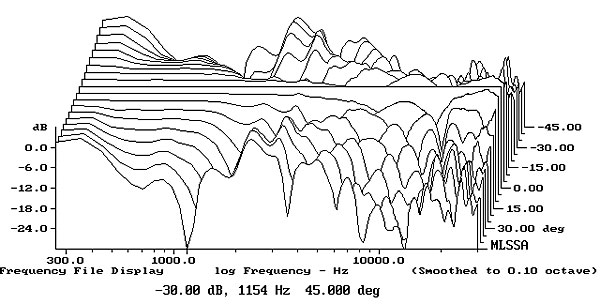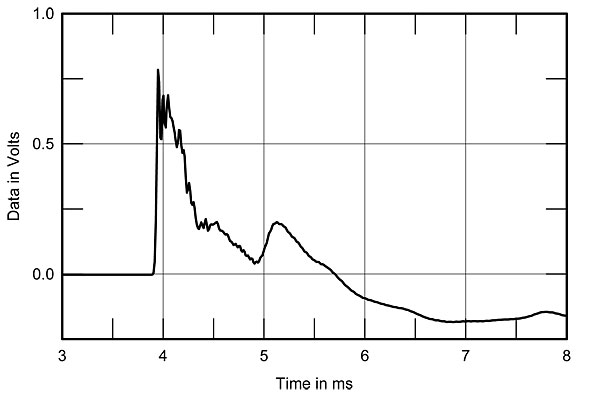| Columns Retired Columns & Blogs |
Audience ClairAudient 2+2 loudspeaker Measurements
Sidebar 3: Measurements
I used DRA Labs' MLSSA system and a calibrated DPA 4006 microphone to measure the Audience ClairAudient 2+2's frequency response in the farfield. For the nearfield and room responses, I used an Earthworks QTC-40. The ClairAudient 2+2's sensitivity was average, at an estimated 88dB(B)/2.83V/m, which is less than the specified 90dB. Its impedance (fig.1) dropped below 4 ohms for most of the midrange and treble and below the passive radiator resonance, with a minimum value of 3.5 ohms between 570 and 1100Hz and 3.4 ohms below 20Hz. Fortunately, the electrical phase angle is fairly low; an amplifier rated at 4 ohms will have no problems driving the ClairAudient 2+2s.

Fig.1 Audience ClairAudient 2+2, electrical impedance (solid) and phase (dashed). (2 ohms/vertical div.)
A suspicious-looking wrinkle in the impedance traces just above 400Hz implies the presence of some sort of resonance. Investigating the enclosure panels' vibrational behavior with an accelerometer uncovered a strong, high-Q resonant mode at 426Hz that was detectable on all surfaces (fig.2). There were also strong modes present at 684, 1125, and 1195Hz. In general, the higher the frequency and the higher the Quality Factor (Q), the lower the likelihood that a resonance will introduce coloration. My own auditioning of the ClairAudients, however, led me to feel that there was a hard character in the midrange that might be due, at least in part, to these resonances, though it's fair to note that Brian Damkroger didn't comment on such a coloration.

Fig.2 Audience ClairAudient 2+2, cumulative spectral-decay plot calculated from output of accelerometer fastened to center of top panel (MLS driving voltage to speaker, 7.55V; measurement bandwidth, 2kHz).
With the stands BD used for his listening, the center of the Clairaudient's baffle was 36" from the floor, which is the ear height of a typical seated listener. So that was the axis on which I measured the 2+2, midway between the two drive-units. The farfield response, averaged across a 30° horizontal window centered on the listening axis, is shown as the black trace above 300Hz in fig.3. While some scattered peaks of energy can be seen in the low and high treble, the response trend is relatively even. This graph was taken with the speaker's grilles removed. As BD did most of his listening with the 2+2s' grilles in place, I repeated the measurement with the grilles. The result was almost identical, other than there being slightly less energy between 3kHz and 10kHz (not shown). I also measured the response at 30" on the axis of each of the eight identical drive-units (two each on the front and back of each speaker), to examine how closely they matched. The individual driver sensitivities were within 0.25dB below 3kHz, which is very good consistency, but varied more in the high treble regarding the height of the peaks between 18 and 28kHz, with a 6dB difference in this region between the "hottest" and "coldest" drivers.

Fig.3 Audience ClairAudient 2+2, anechoic response on listening axis at 50", averaged across 30° horizontal window and corrected for microphone response, with nearfield woofer (blue trace) and port (red) responses and their complex sum (black), plotted below 700, 500, and 300Hz, respectively.
Lower in frequency, a large midrange suckout can be seen in fig.3. This is due to destructive interference between the two drive-units on the front panel and the two on the speaker's rear. Whether or not it will be audible will depend on the acoustics of the room in which the ClairAudient 2+2s are used, their positions within that room, and their radiation pattern. However, BD said that when he first set up the speakers, "the Audience's sound had a lazy feel that at first sounded kind of flat and dull"—just what I would have expected from this measured behavior. He does appear to have accommodated to the balance, however, noting that, "far from sounding flat or the least bit dull, voices practically jumped out of the soundstage."
The blue trace in fig.3 shows the response of one of the four identical drive-units, measured in the nearfield. There is no midrange suckout, confirming that the suckout in the black trace must be due to interference in the farfield between the front- and rear-firing units. The output rolls off smoothly below 150Hz, with a sharp notch evident at 57Hz, the tuning frequency of the side-mounted passive radiator. The output of this radiator (red trace) peaks at its tuning frequency, with sharp rolloffs above and below. The summed low-frequency response rolls off steeply below 50Hz, implying modest bass extension.
Figs. 4 and 5 show how the ClairAudient 2+2's response changes to the sides of the listening axis, with the responses measured on the speaker's passive-radiator side presented at the rear of the graph. Fig.4 shows the actual responses, fig.5 just the changes in response. The interference suckout in the midrange does fill in to the speaker's sides, but there is a rather complicated pattern of peaks and dips off axis in the midrange and low treble. As might be expected from its use of a drive-unit with a larger diameter than the usual 1" tweeter, the 2+2's dispersion narrows significantly in the top two audio octaves. In all but small rooms, this will make the ClairAudients sound a little lifeless; as BD commented, the speaker did "lack a bit of energy [in] the very top." With its two spaced drivers on both front and rear baffles, the Audience's radiation pattern in the vertical plane was also very complicated (fig.6), suggesting that it is important to use stands that place the listener's ears on the optimal axis, midway between the drive-units.

Fig.4 Audience ClairAudient 2+2, lateral response family at 50", from back to front: responses 90–5° off axis on passive-radiator side, reference response, responses 5–90° off axis on other side from passive radiator.

Fig.5 Audience ClairAudient 2+2, lateral response family at 50", normalized to response on listening axis, from back to front: differences in response 90–5° off axis on passive-radiator side, reference response, differences in response 5–90° off axis.

Fig.6 Audience ClairAudient 2+2, vertical response family at 50", normalized to response on listening axis, from back to front: differences in response 45–5° above axis, reference response, differences in response 5–45° below axis.
Intrigued by the Audience 2+2's quasi-anechoic measurements, I set up the pair of them in my own room, atop 24"-high Celestion stands and driven by Musical Fidelity's AMS100 class-A amplifier. Each speaker was positioned about 27" from the nearest sidewall (measured from the front drive-units) and well in front of the wall behind it. The passive radiators faced each other, which was how BD had listened to them. The red trace in fig.7 shows the spatially averaged, 1/6-octave response of the Audience 2+2s in my listening room. While the midrange suckout has indeed filled in somewhat, as anticipated from the lateral-dispersion graphs, the level of the upper midrange is excessive and is not balanced by the bass, which is shelved down. This suggests that the speakers need more than the usual amount of reinforcement from the wall behind them, though this was not possible in my room. The low frequencies also roll off sharply below 60Hz, and the excitation of the lowest-frequency mode in my room, around 30Hz, is not happening to any significant extent.

Fig.7 Audience ClairAudient 2+2, spatially averaged, 1/6-octave response in JA's listening room (red trace); and of Harbeth P3ESR (blue).
For reference, the blue trace in fig.7 shows the spatially averaged response of the Harbeth P3ESRs in my room, with which BD had compared the Audiences. The low-frequency alignment of the Harbeth's woofer is tuned no higher than that of the ClairAudient's full-range drivers, but the slower, sealed-box rolloff of the Harbeth gives it significantly more audible midbass energy in my room. The P3ESR is also very much more neutrally balanced in the midrange and treble than the ClairAudient 2+2, so I am at somewhat of a loss to explain why BD found that the Audience "seemed to go a bit lower, and sounded warmer and more harmonically rich throughout the midrange," than the Harbeth.
As BD discussed, the glory of using a single full-range drive-unit is that the power-sucking and possibly detail-destroying crossover can be eliminated. The result is that the speaker is inherently time-coincident, and has the potential for superb time-domain behavior. The ClairAudient 2+2's step response on the listening axis is shown in fig.8. What could have been a good, right-angle-triangle shape to the step is disturbed by a another pulse of energy arriving about 1.3 milliseconds after the initial, well-defined start of the step. It is the interference between these two arrivals that gives rise to the midrange suckout in the quasi-anechoic response on this axis seen in fig.3.

Fig.8 Audience ClairAudient 2+2, step response on listening axis at 50" (5ms time window, 30kHz bandwidth).
Finally, fig.9 shows the ClairAudient 2+2's cumulative spectral-decay plot on the listening axis. The midrange cancellation suckout makes its presence known, but in some ways this graph reveals excellent performance—for example, the very quick die-away of the sound through much of the treble. However, ridges of resonant energy can be seen at 1.8, 3.6, and 8.8kHz (the cursor position), and above 20kHz. The ultrasonic peaks are subjectively inconsequential, but those lower in frequency are of some concern, I feel.

Fig.9 Audience ClairAudient 2+2, cumulative spectral-decay plot on listening axis at 50" (0.15ms risetime).
The Audience ClairAudient 2+2's measured performance is difficult to sum up. I fully understand and appreciate the appeal of using a single full-range drive-unit, and Audience's engineers have done what might have been thought impossible: designed a drive-unit that can be used to cover the range from 100Hz to 30kHz and above. But as much as BD liked the ClairAudient's sound, I felt it had too much upper-midrange energy in absolute terms—although this undoubtedly contributed to its superb presentation of recorded detail—as well as some hardness to its balance that could well be laid at the feet of the resonant behavior of both the drive-unit and the enclosure.
Given the disparity between Brian Damkroger's and my feelings about the sound quality of the Audience ClairAudient 2+2, I feel that a careful audition before purchase will be essential.—John Atkinson
- Log in or register to post comments




































